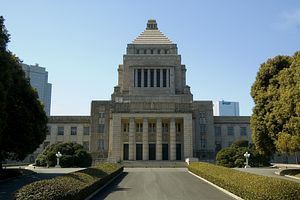The two factions of Japan’s second largest opposition party Nippon Ishin no Kai (Japan Restoration Party) formally split on Sunday. The eastern portion led by former Tokyo governor Shintaro Ishihara will retain 23 of Japan Restoration Party’s original 62 Diet members, while the western faction led by Osaka Mayor Toru Hashimoto will have 37. The two remaining lawmakers will become independents.
The two sides are very much aware of how this split will further shrink their limited voice in the national government. During a party convention on Sunday Hashimoto said, “We are the first opposition party that is ready to cooperate with the government where needed… We want to join hands even after breaking up.” It is clear that in the face of the ruling LDP’s overwhelming majority in both houses of the Diet, Hashimoto understands that cooperation with the government and his former ally will be important if he hopes to retain any sort of national presence.
Ishin no Kai had been in talks to join with Yui no To (Unity Party), but those broke down over Yui no To’s unwillingness to go along with Ishihara’s goal of changing Japan’s pacifist constitution. Hashimoto plans to join his faction with Yui no To by the end of July, and has also expressed hope that some members of Japan’s largest opposition party, the DPJ, will join in his new coalition. However, Yui no To’s 14 lawmakers would only bring Hashimoto’s party to 51, making his national presence smaller than his original pairing with Ishihara.
The Japanese opposition in general has had a very difficult time organizing itself since the LDP returned to power in December 2012. Since then the government has enacted a raft of economic reforms designed to bring the country out of deflation toward stable growth, as well as focused on changing the constitution (or at least the interpretation of it) to allow for a more normalized Japanese military. While the government and the Bank of Japan appear on track to reach their 2 percent inflation target, the third portion of Abenomics, designed to bring about significant structural reform of the Japanese economy, has been light on details, and what details have emerged don’t indicate systemic economic reform is likely. Abe’s attempts to include collective self-defense in the interpretation or writing of the Constitution is also becoming increasingly unpopular, with 55 percent of the public opposed to the idea, up from 48.1 percent in June, according to a nationwide poll.
The Japanese opposition appears unable to capitalize on policies that are either unpopular or insufficient to meet the country’s needs. At a recent party leader debate where the issue of collective self-defense was discussed, instead of attacking Abe over his attempts to change Japan’s military posture, DPJ leader Banri Kaieda had to defend himself after Abe chastised him for being unable to reach consensus within his own party on the issue. Aside from the breakup of Ishin no Kai and the DPJ’s inability to lead an effective opposition, other small parties like Yui no To have been dealing with scandals, such as one last April when its leader had to step down over unregistered loans. Unless Japan’s opposition parties are able to select an issue around which to cooperate and challenge the LDP, the only thing likely to impede the government is its own fumbles.

































